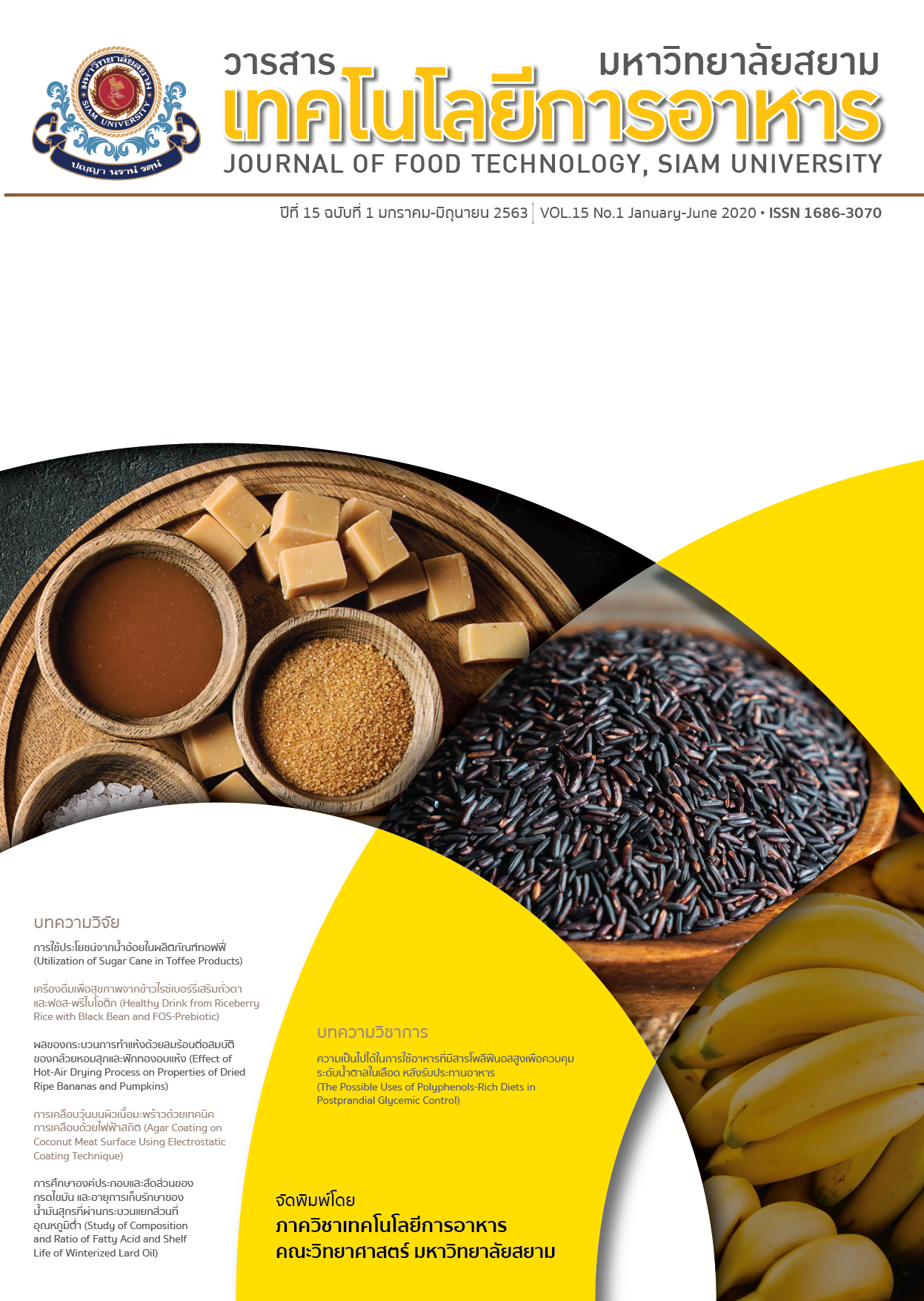Study of Composition and Ratio of Fatty Acid and Shelf Life of Winterized Lard Oil
Main Article Content
Abstract
This research aims to study composition and ratio of fatty acid and shelf life of Kurobuta and Three-Crossbred lard oils in order to use as primary data for the development of industrial lard oil production. Lard oils from the 2 pig breeds were prepared by rendering ground fats at 90-140 ºC, 1 hour and winterizing the lard oils in two steps: (1) at 28 ºC, 48 hours and (2) at 26 ºC, 48 hours. Rendering yields of Kurobuta and Three-Crossbred lard oils were measured at 60.96% and 59.14%. Winterization yields from Three-Crossbred lard oil was 25.13% and the yield from Kurobuta lard oil was 20.54%. Saturated fatty acid (SFA), monounsaturated fatty acid (MUFA) and polyunsaturated fatty acid (PUFA) from Kurobuta lard oil were 34.28%, 42.37% and 18.37%, respectively. SFA, MUFA and PUFA content of Three-Crossbred lard oil were 33.76%, 41.41% and 19.83%. Kurobuta lard oil contained 1.03, 17.32, 2.24 and 40.11 g/100g of omega 3, 6, 7 and 9. Three-Crossbred lard oil contained 1.15, 18.68, 2.04 and 39.35 g/100g of omega 3, 6, 7 and 9. Trans-fat was not found in the lard oils. Shelf life of Kurobuta and Three-Crossbred lard oils at 24±1 ºC under lighted conditions were 75 and 60 days, respectively.
Article Details
Copyrights of all articles in the Journal of Food Technology available in print or online are owned by Siam University and protected by law.
References
Orsavova, J., Misurcova, L., Ambrozova, J.V., Vicha, R., and Mlcek, J. (2015). Fatty acids composition of vegetable oils and its contribution to dietary energy intake and dependence of cardiovascular mortality on dietary intake of fatty acids. International Journal of Molecular Sciences. 16: 12871-12890.
Rohman, A., Triyana, K., Sismindari, and Erwanto, Y. (2012). Differentiation of lard and other animal fats based on triacylglycerols composition and principal component analysis. International Food Research Journal. 19(2): 475-479.
Mattson, F.H. and Lutton, E.S. (1958). The specific distribution of fatty acids in the glycerides of animal and vegetable fats. Journal of Biological Chemistry. 233(4): 868-871.
Kostik, V., Memeti, S., and Bauer, B. (2013). Fatty acid composition of edible oils and fats. Journal of Hygienic Engineering and Design. 4: 112-116.
Scanes, C.G. (2018). Animal Products and Human Nutrition. Animals and Human Society. 41–64.
Woodgate, S.L. and van der Veen, J.T. (2014). Fats and Oils – Animal Based. Food Processing: Principles and Applications. 2nd Edition. John Wiley & Sons, Ltd.
Arnold, L.A. and Cleveland, R.S. Winterized vegetable oil and process of producing the same. United State Patent Office. US2,607,695. Patented Aug. 19, 1952.
Ritruengdech, K., Sajjapibul, C., and Klinkesorn, U. (2550). Quality Improvement Of Lard Using Dry Fractionation. in: 33rd Congress on Science and Technology of Thailand (STT.33) : Science and technology for global sustainability 18-20 October 2007. Faculty of Agro-Industry, Kasetsart University, Bangkok.
Gooding, C. Winterization process. United States Patent Office. US3,048,491. Patented Aug. 7, 1962.
Wootton, J.C. Process for the improved winterization of oil. United State Patent Office. US3,360,533. Patented Dec. 26, 1967.
Morrison, W.H. and Thomas, J.K. (1976). Removal of waxs from sunflower seed oil by miscella refining and winterization. Journal of the American Oil Chemists' Society. 53(7): 485-486.
Pushpinder, S.P. (1980). Winterization of oils and fats. Journal of the American Oil Chemists' Society. 57(11): A848-A850.
Yokochi, T., Usita, M.T., Kamisaka, Y., Nakahara, Y., and Suzuki, O. (1990). Increase in the ɤ- linolenic acid content by solvent winterization of fungal oil extracted from Mortierella genus. Journal of the American Oil Chemists' Society. 67(11): 846-851.
Campos, R., Narine, S.S., and Marangoni, A.G. (2002). Effect of cooling rate on the structure and mechanical properties of milk fat and lard. Food Research International. 35: 971-981.
Lopez-Martinez, J.C., Campra-Madrid, P., and Guil-Guerrero, J.L. (2004). ɤ- linolenic acid enrichment from Borago officinalis and Echium fastuosum seed oils and fatty acids by low temperature crystallization. Journal of Bioscience and Bioengineering. 97(5): 294-298.
Takahashi, H. (2004). Swine Breeding Systems to Enhance Pork Quality in Japan. Swine Improvement Federation. 29th Annual, 81-87.
Ravansook, S. (2004). Swine Breeding Systems of Charoen Pokphand Companies (CP) in Southeast Asia. Swine Improvement Federation. 29th Annual, 77-80.
Campbell, N.A. and Reece, J.B. (2001). Biology 6th edition. Benjamin Cummings, San Francisco.
Finucane, O.M., Lyons, C.L., Murphy, A.M., Reynolds, C.M., Klinger, R., Healy, N.P., Cooke, A.A., Coll, R.C., McAllan, L., Nilaweera, K.N., O’Reilly, M.E., Tierney, A.C., Morine, M.J., Alcala-Diaz, J.F., Lopez-Miranda, J., O’Connor, D.P., O’Neill, L.A., McGillicuddy, F.C., and Roche, H.M. (2015). Monounsaturated fatty acid–enriched high-fat diets impede adipose NLRP3 inflammasome–mediated IL-1β secretion and insulin resistance despite obesity. Diabetes. 64(6): 2116-2128.
Garg, A. (1998). High-monounsaturated-fat diets for patients with diabetes mellitus: a meta-analysis. The American Journal of Clinical Nutrition. 67(3): 577S–582S.
Yun, J. M. and Surh, J. (2012). Fatty acid composition as a predictor for the oxidation stability of Korean vegetable oils with or without induced oxidative stress. Preventive Nutrition and Food Science. 17(2): 158–165.


